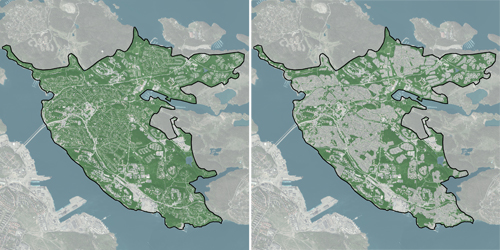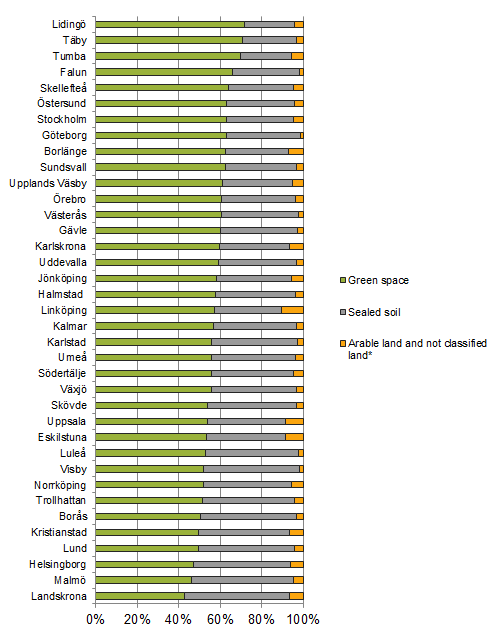Green areas within and around urban areas 2010:
Lidingö is the greenest urban area
Statistical news from Statistics Sweden 2015-05-28 9.30
Lidingö in Stockholm County was the greenest urban area in 2010, with regard to the proportion of green space of the land area. Roughly 72 percent of the land was in some form of green structure. However, Borlänge is the greenest urban area if we regard green space per urban area inhabitant, with over 500 square meter of green space per inhabitant.

Statistics Sweden has studied the green structure in 37 larger urban areas in Sweden, that is, urban areas with at least 30 000 inhabitants as well as the urban area of Visby (Gotland), to cover the largest urban areas in each county. Most of these larger urban areas had a total green structure that exceeded 50 percent of the land area. Only five of 37 urban areas have a share of green structure that was less than 50 percent of the land area, and all of these areas were in Skåne. The lowest share of green space was in the urban area of Landskrona where only 43 percent of the land consisted of green space.
On average, about one-fourth of urban areas' green space was connected to private gardens and thus not accessible to the public. Luleå, Landskrona and Örebro had the largest share of green space accessible to the public, over 80 percent. This can be compared to the corresponding share in Täby which was 51 percent.

* Not classified land is land that could not be attributed to either green space or sealed soil area.
Most sealed soil areas in Landskrona
Landskrona was the urban area that had the largest share of sealed soil. More than half of the land area consisted of buildings, infrastructure and other sealed soil areas. The four urban areas that had the largest share of sealed soil are all in Skåne County. Lidingö and Tumba had the smallest share of sealed soil at less than 25 percent each.
Good access to green space within 300 meters from home
The distance between green space and housing, workplaces and schools etc. affects the possibility to use an area regularly. Access to green space within 300 meters from home is good for most of the urban areas. In 26 urban areas, one percent or less lack green space within 300 meters. In Karlskrona, 9 percent lacked green space within 300 meters, which was the highest share. The distance corresponds to a walking distance of less than 5 minutes.
The calculations are based on the distance in a straight line without regard to any physical barriers such as infrastructure or water.
Fewer had access to green space within a shorter distance
Short distances between home and green space are important for children and older persons. Children's activities usually occur 200 meters from the home. When the distance is reduced from 300 to 200 meters, a considerably larger share of the population does not have access to one or more green spaces. However, the variations are considerable among urban areas, and some differences are also found among age groups within the same urban area. Karlskrona was the urban area where the largest share of the total urban area population, 18 percent, lacked green space within 200 meters, while Malmö had the largest share of 0-6 year-olds, 15 percent, who lacked access to green space within the same distance.
Sharp differences in distance to bodies of water
Close proximity to lakes, watercourses and the sea are important for an active outdoor life. Even if water is not included in the green structure, we often talk about areas with bodies of water (blue space) to accentuate water as a complement to green space. The access to bodies of water within 300 meters from the home varied sharply among urban areas. In Lund only 2 percent of the population had bodies of water within 300 meters from home, while the corresponding share in Karlskrona was roughly half the population. If we look at all age groups in the 37 urban areas, it is more common that the population over age 65 has close access to bodies of water than children aged 0 - 6.
Feel free to use the facts from this statistical news but remember to state Source: Statistics Sweden.
